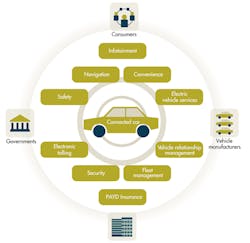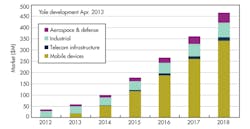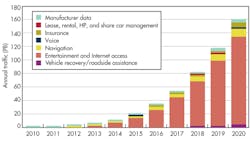This file type includes high resolution graphics and schematics when applicable.
As established technologies improve, clever designers and industry experts have a way of finding new applications and markets for growing technologies. This is very much the case with RF and microwave technologies, as the consumer demand for staying constantly connected spills over into other industries. This trend is now extending to automobiles (Fig. 1). Wireless coverage has to catch up to the demand of its data-hungry users. To meet this demand, terrestrial-based wireless communications are being augmented by ever-more-capable communications satellites. A few facts, figures, and forecasts on mobile communications and connected automotive solutions may help to streamline the jumble of growth opportunities in the RF and microwave world.
Related Articles
• Automobiles Racing To Higher Frequencies
• MM-Wave Radar Guards Automobiles
• Pinpoint And Plan For EMI Sources In Automobiles
Most mobile RF applications would not be possible without the semiconductor-based solutions that transformed RF components from rack-mounted units to pocket-portable tools for everyday life. Insights on what to expect from the RF industry can be gleaned by taking a look into the production of RF integrated circuits (ICs) and the industries for which they are produced. An updated study by IC Insights, titled “IC Market Drivers 2013—A study of Emerging and Major End-Use Applications Fueling Demand for Integrated Circuits,” notes that the communications-IC market grew with a compound annual growth rate (CAGR) of 16% from 2009 to 2013. It surpassed the computer-IC market by reaching as much as $100 billion dollars in 2013. This coincides with a report from IDC, which predicts that smartphones will overtake feature-phone sales by over 10% in 2014—thereby growing to almost twice the size of the feature-phone market by 2017. The need for smartphones to have additional antenna elements and radio streams increases the necessary RF components of the smartphone beyond feature-phone requirements.
While mobile-phone sales grow, mobile-communications standards are advancing to provide higher data rates while incorporating multiple antennas and advanced features. These advancements, which require more RF-semiconductor development, have demonstrated a rise in production of these components. At the RF MEMS Conference in 2013, a forecast report by Yole Development predicted that the RF microelectromechanical-systems (MEMS) switch and variable capacitor market will grow from more than 50+ million in 2013 to more than 450 million in 2018 (Fig. 2). The forecast noted that the mobile-device market dominates this demand with over 50% of the market share. A number of reports and studies support the theory that the desire for constant high-speed connections by consumers is driving mobile sales and the investment in the telecommunications infrastructure.
Cisco shares many statistics and predictions on the mobile communications market in its report, “Visual Networking Index Forecast (VNI).” According to the forecast, there will be 841 million mobile-connected devices in 2017—an increase of almost 400 million compared to 2012. With an estimated increase from 1.26 mobile connections per capita in 2012 to 2.2 from the report, it would stand to reason that mobile data traffic would scale as well. The report predicts that mobile data traffic will hit over 1 exabytes per month, used by over 300 million people in 2017. It also indicates that 7% of the mobile data traffic in 2017 will be from machine-to-machine (M2M) connections with almost 350 million mobile-connected M2M modules. As more “smart” systems are incorporated into daily life every year, such reports show that machine and human communications will spread to more diverse platforms. Automobile communication, or telematics, is an industry that is poised to take advantage of the communications infrastructure boom.
This file type includes high resolution graphics and schematics when applicable.
On-The-Go Data Demand
This file type includes high resolution graphics and schematics when applicable.
With a 25.4-minute average commute (according to the U.S. Census Bureau), most Americans spend almost 1.5 hours a day traveling (according to the Bureau of Labor Statistics American Time Use Survey). In total, most Americans find themselves in a car for almost five years of their lives, which leaves them with a lot of time on their hands in transit. This could attribute to the forecasting by Machina Research, which predicts that over 120 petabytes of information will be transmitted a year just for entertainment and Internet traffic in in-vehicle mobility systems by 2020 (Fig. 3). Common telematics solutions include feature enhancements and added features to the automobile ecosystem, such as security/tracking, emergency/eCall, entertainment and Internet, navigation, insurance, and lease/rental/share car management. In a whitepaper written by SBD for GSMA, “2015 Every Car Connected: Forecasting the Growth and Opportunity,” an estimation of the growth of embedded in-car telematics over the next 15 years is predicted to reach over 5% of all connected devices by 2025. In other words, roughly 0.1% of connected devices would be embedded in-car telematics solutions. Although there is a high demand from consumers to see telematics systems in everyday cars, there are reasons that the forecast for embedded telematics is predicted to only grow significantly in the late 2010s.
For instance, automobile design cycles operate on a 3-5 year basis, whereas mobile technologies update annually. The life spans of automobiles typically range from 7-10 years. This means that in-vehicle telematics solutions must be able to be updated remotely, require few hardware updates, and be highly resistant to the stresses of vehicular travel. Telematics solutions also need to be operating across brands and models to provide a more general solution, as designing solutions for each specific model would cause difficulties and delays in the incorporation of the technology. Additionally, automakers want solutions that can be adjusted to changes in markets, business models, mobile operators, and vehicle ownership. This need could lead to embedded devices, tethered devices, or integrated devices with mobile handsets.
All of these telematics solutions require a reliable communications network in which automakers can assure users of 99.999% functionality, according to GSMA’s white paper, “Connecting Cars: The Technology Roadmap.” This requirement—along with historical cooperation difficulties between mobile network operators (MNOs) and automakers—has led to delays in telematics solutions. An additional complication stems from recent changes in the European Union (EU) wireless regulations. Automakers’ telematics solutions may take some time to arrive to market, which means aftermarket telematics solutions might grow to fill the gap in consumer demand.
One such solution could be the new embedded subscriber identity module (SIM) technology, which enables operator swapping without the need to physically possess the device. This could allow for the adaptability necessitated by the long life cycles of automobiles. In an excerpt from “2015 Every Car Connected: Forecasting the Growth and Opportunity,” the following hypothesis is provided:
Related Articles
• Automobiles Racing To Higher Frequencies
• MM-Wave Radar Guards Automobiles
• Pinpoint And Plan For EMI Sources In Automobiles
“At some point in the future, every car will need to be connected to the outside world through a cellular network. The most user-friendly and secure way to enable this is by embedding a SIM card and a communication module inside the car. Therefore, the automotive market will naturally converge towards embedded telematics in the long term unless major barriers prevent this from occurring.”
Connecting cars may add many new technology opportunities and user benefits. Yet such capability also invites the potential for technological assaults on the telematics solutions within the vehicle. Each connectivity option allows for another method of potential intrusion. As such, high-tech thefts are a key consideration for automakers.
Additional Resources
"Connected Car Forecast Next Five Years"
"Summary Of Travel Trends: 2009 National Household Travel Survey"
This file type includes high resolution graphics and schematics when applicable.
About the Author
Jean-Jacques DeLisle
Jean-Jacques graduated from the Rochester Institute of Technology, where he completed his Master of Science in Electrical Engineering. In his studies, Jean-Jacques focused on Control Systems Design, Mixed-Signal IC Design, and RF Design. His research focus was in smart-sensor platform design for RF connector applications for the telecommunications industry. During his research, Jean-Jacques developed a passion for the field of RF/microwaves and expanded his knowledge by doing R&D for the telecommunications industry.




